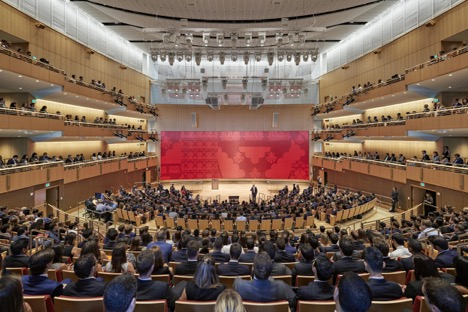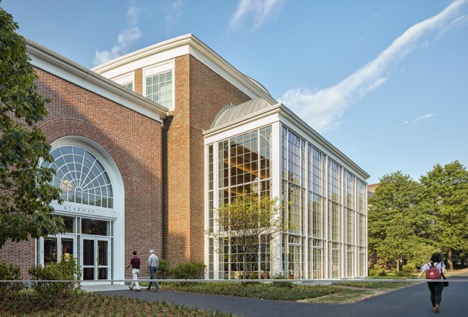
On October 1, the southeastern corner of campus featured a flurry of events as HBS dedicated Klarman Hall, a brand-new venue that brings many new possibilities to the community. But that day was not the first time that an event was held in Klarman; it was the culmination of years of planning.
The story of Klarman goes back to the deanship of Jay O. Light, whom Nitin Nohria succeeded in 2010. Light began the process of creating a new campus master plan, something that the School files with the City of Boston approximately once every 10 years. The idea for the building emerged in that process, said Andrew O’Brien, chief of operations at HBS.
Klarman replaces Burden Hall, which opened in 1971 and for nearly half a century functioned as the School’s venue for large-scale classes, events, lectures, and alumni reunions. Klarman is located next to the Spangler Center; the land on which Burden sat, just north of the Klarman site, is now home to the HBS Commons Pavilion. (As this story went to press, Google Maps still showed an outline of Burden and had no rendering of Klarman.)
The primary purpose of Klarman is to serve as a gathering center, and it will expand the School’s capacity for events significantly. Burden’s auditorium contained only 750 seats. Since each MBA class includes over 900 students, space was tight. When an entire class gathered in Burden, some students had to sit in folding chairs; others even had to stand at the back of the hall.
Klarman solves the capacity issue for MBA classes and opens up many more possibilities. O’Brien remarked, “HBS has an amazing power to convene people. At 750 seats, it felt as though we were falling short of what we could possibly do.” The new auditorium has 1,000 seats. Its design in three seating sections also makes it appropriate for smaller events of up to 250 or 580 guests.
Despite Klarman’s huge scale, it is meant to preserve some key elements of the HBS classroom experience, explained Brian C. Kenny, the School’s chief marketing and communications officer. For example, the walkways resemble the aisles in an Aldrich classroom, enabling presenters to walk amidst their audience. Microphones descend from the ceiling to create a voice reinforcement system, and glass panels over the stage can be adjusted in both height and angle to optimize the acoustic of the room for conversation among event attendees.
Certain key design choices were inspired by conversations that School staff members had with consultants from New York’s Lincoln Center, some of whom are alumni. About five years ago, a team from Lincoln Center came to HBS to share their insights about how to convene people. And this summer, the newly built Klarman was “tuned” with the same process that Lincoln Center used for Alice Tully Hall.
Construction began in March 2015 and finished this July; at its peak, there were 300 construction workers onsite. The process went smoothly, O’Brien said. Originally, HBS planned to tear down Burden after the completion of Klarman Hall, but in the summer of 2017, the School accelerated the demolition timeline, a decision that received criticism in the opinion pages of this newspaper (“Burden Hall Should Not Be Demolished This Soon,” October 2017). With last month’s launch of Klarman Hall, the gap in campus facilities has been closed.
In advance of the public dedication, HBS held a number of events in Klarman. In August, while students were still away, 800 staff members gathered for an event to test the acoustic. On the morning of August 30, RCs reported to Klarman to kick off their two years at HBS with START. The Class of 2020 is the first ever to sit in the Hall. In September, they returned to Klarman for a CPD presentation as well as the launch of FIELD Global Immersion, which featured an impressive screening of a video introduction to FGI on Klarman’s 1,250-square-foot, 32-million-pixel video wall.

More recently, Executive Education held its Advanced Management Program graduation ceremony in the building. Professors Robin Greenwood and David S. Scharfstein led a conference on the 10th anniversary of the global financial crisis. And outside Klarman, on the Pavilion, RCs and ECs together enjoyed an SA-sponsored happy hour. As Kenny noted, the Pavilion, with its use of a trellis, echoes outdoor spaces at Stanford.
The dedication ceremony on October 1 drew several high-profile guests, including Massachusetts Governor Charlie Baker, JPMorgan Chase Chairman and CEO Jamie Dimon (MBA ’82), and Harvard President Lawrence S. Bacow. It featured remarks by Beth S. and Seth A. Klarman (MBA ’82), whose financial gift made the new building possible.
Beth Klarman said, “It is my hope that those who come to Klarman Hall will remain open to listening to a productive exchange of ideas, to learning from disagreements, and perhaps grow as a result of them. May this space be a place to develop and share ideas which will have a positive impact on the people who come together in this room and on those in the world beyond.”
In keeping with the Klarmans’ vision for the building as a place for dialogue, the ribbon-cutting was followed by presentations and a panel discussion related to democracy.
As he concluded the dedication ceremony, Seth Klarman remarked, “Beth and I hope that this new facility will help Harvard surface and shine a bright light on facts and ideas, and that this will contribute to a rebirth of thoughtful discourse and respectful debate. And it’s no small thing that this convening, this exchange of ideas and perspectives, framed by respect and compassion for one another and a reverence for facts, brings people together face-to-face.”

Gabriel Ellsworth (MBA ’20) came to HBS from HBS, where he worked for five years as a research associate, most recently as a casewriter with a faculty member in the Strategy Unit. He read English literature as an undergraduate at Yale. When he first came to work at HBS, a 1953 building called Kresge Hall still stood where the Chao Center is now located.


